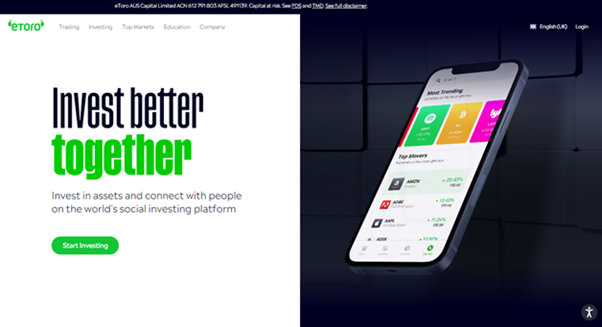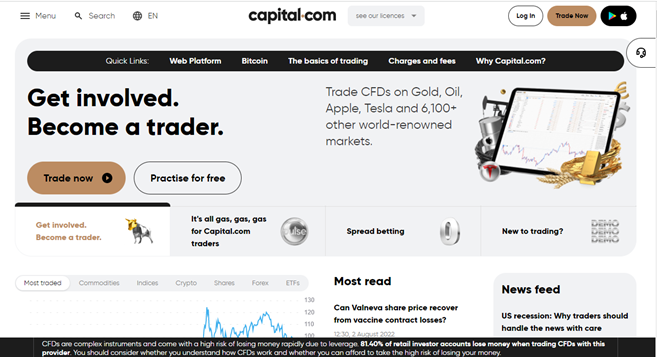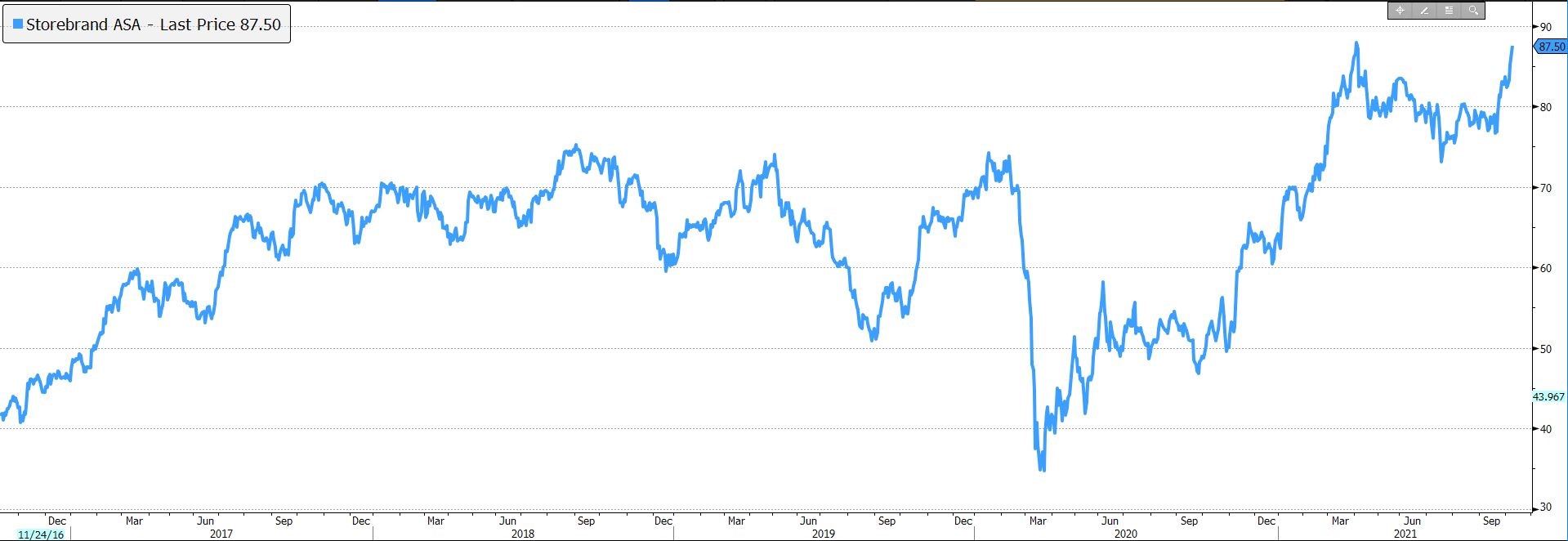How to buy Storebrand stocks in 2025

Storebrand is a company that specialises in the financial services industry and has its headquarters in Norway. The company's main activities include life insurance and pension savings, property and casualty insurance, investment management, and private banking. Storebrand has been in existence for more than 250 years and is the largest private asset manager in Norway, with NOK 1,000 bn in assets invested in more than 3,000 companies globally. This article takes you on a deep dive into the operations and management of Storebrand, explaining fundamental factors affecting the stock price and tips to keep in mind when trading Storebrand.
How to Buy SREDF Stocks in 5 Easy Steps
-
1Visit eToro through the link below and sign up by entering your details in the required fields.
-
2Provide all your personal data and fill out a basic questionnaire for informational purposes.
-
3Click 'Deposit', choose your favourite payment method and follow the instructions to fund your account.
-
4Search for your favourite stock and see the main stats. Once you're ready to invest, click on 'Trade'.
-
5Enter the amount you want to invest and configure your trade to buy the stock.
Best Reviewed Brokers to Buy Storebrand Stocks
1. eToro

eToro is one of the most prominent social investment networks, with a mission to improve investors' knowledge and activity regarding finance. Since its inception in 2007, eToro has become the premier investment platform for novice and experienced traders, with a user base of over 17 million. You can read our full eToro review here.
Security and Privacy
When choosing an investment platform, security is among the biggest factors to consider. Since eToro is regulated by the Financial Conduct Authority (FCA) and the Cyprus Securities and Exchange Commission (CySEC), you can be assured that your funds and personal details are secure. Furthermore, eToro SSL encrypts all submissions to safeguard against hackers trying to intercept confidential information. Finally, the platform has two-factor authentication (2FA) to ensure the users’ accounts are safe.
Fees & Features
Both inexperienced and seasoned investors can take advantage of eToro's extensive library of cutting-edge trading methods. For instance, beginners in trading can take advantage of CopyTrading available on eToro as it allows them to mimic the actions of more experienced traders. Those with trading experience will be glad to find that eToro provides access to many markets, such as stocks, currencies, and cryptocurrency, all from one platform. Also, eToro is a commission-free service. However, the platform charges a monthly fee of £10 for inactivity to promote active trades on the platform.
| Fee Type | Fee Amount |
| Commission Fee | 0% |
| Withdrawal Fee | £5 |
| Inactivity Fee | £10 (monthly) |
| Deposit Fee | £0 |
Pros
- Copy trading feature
- SSL encryption to protect users' information
- Trading is commission-free
Cons
- Limited customer service
2. Capital.com

Capital.com, which originated in 2016, is an excellent multi-asset broker. With over 5 million users, it has established itself as a low-cost platform with low overnight fees, tight spreads, and 0% commission. You can read our full Capital.com review here.
Security and Privacy
Capital.com is an FCA, CySEC, ASIC, and NBRB-licensed corporation dedicated to providing the most effective trading experience in the world. It shows that users' data is secured and hidden on Capital.com, since the site follows stringent criteria to achieve this goal. Capital.com takes client data security seriously, and one way it does this is by complying with the PCI Data Security Standards.
Fees & Features
Capital.com offers a wide variety of no-cost brokerage services. Its financial policies are transparent. Any fees you incur will be made clear before you pay them. Capital.com's principal costs come from spread charges, which are often low compared to competitors. The broker's mobile trading app features an AI-powered tool that gives clients personalized trading information by employing a detection algorithm. In addition, Capital.com's multilingual customers can get in touch with a representative via email, phone, or live chat.
| Fee Type | Fee Amount |
| Deposit Fee | £0 |
| Commission Fee | 0% |
| Inactivity Fee | £0 |
| Withdrawal Fee | £0 |
Pros
- Efficient email and chat support
- MetaTrader integration
- Commission-free trading
Cons
- Majorly restricted to CFDs
3. Skilling

Skilling is a multi-asset broker with significant growth. The broker offers excellent trading conditions regarding platform features and products available to experienced traders. Skilling now provides Forex, CFD, Stock, and cryptocurrency trading six years after its inception to individual investors. You can read our full Skilling review here.
Security and Privacy
When looking for a broker like Skilling, it is essential to check the broker's regulatory standing. Skilling is administered by the Financial Conduct Authority (FCA) and the Cyprus Securities and Exchange Commission (CySEC). In addition, the money that traders deposit into their Skilling accounts is held in a completely independent financial institution. For maximum safety, Skilling only uses top-tier financial institutions for this purpose. Tier 1 capital is the industry benchmark for measuring a bank's soundness.
Fees & Features
Skilling does not charge commissions for trading equities, indices, or cryptocurrencies. The platform charges Spreads which vary based on the share, but are typically very reasonable. Skilling offers two distinct account options for FX and metals CFD trading. The Standard Skill account has significantly larger spreads but no commissions. The Premium account charges commissions on spot metal and FX CFD trades for decreased spreads. Additionally, Skilling provides a demo account, mobile applications, and a trade assistant.
| Fee Type | Fee Amount |
| Commission Fee | £0 |
| Withdrawal Fee | Varies |
| Inactivity Fee | £0 |
| Deposit Fee | £0 |
Pros
- Great platform choice
- Demo accounts
Cons
- High Spreads
- Service is unavailable in many countries, including the US and Canada.
Everything You Need To Know About Storebrand
It is essential to understand the company's business model and how it makes money before you decide to invest in it. Below is a deep dive into the operations of Storebrand.
Storebrand History
The company was formed in 1767 under the name Den almindelige Brand-Forsikrings-Anstalt which later changed to Norges Brannkasse. In 1982, Storebrand merged with its competitor Norden, an insurance company, to form the Storebrand-Norden Group. The company's name was later changed to AS Storebrand in 1986.
After a failed merger in 1991 with Swedish, Finnish, and Danish insurance companies, the stock price plummeted, and the Norwegian government took control of the company. However, in 1993, the company was able to restructure its debt successfully and was once again able to relist on the Oslo Stock Exchange.
What Is Storebrand's Strategy?
Storebrand's management has acknowledged that there have been significant changes to the European insurance and pension sector. In a low interest rate environment and changing regulatory conditions for long-term pensions savings, there has been a shift from traditional pension plans with guaranteed annual interest rates to savings plans without guarantees. In response to these changes, Storebrand has developed a two-pronged strategic response.
The company first plans to maintain new regulatory requirements with a solvency II ratio of a minimum of 150%. Management has implemented strict measures to satisfy this new capital requirement. As a result, the company can engage in balance sheet management and better employ its assets without taking too much risk.
The second strategy is to grow the business via "Recommendation by customers" or the word-of-mouth approach for a more organic growth method. The company plans to leverage its strong customer offering and its substantial market share and market position in occupational pensions to grow the business line.
How Does Storebrand Make Money?
Storebrand has four primary operating arms which generate revenue. The four main sources of revenue are as follows:
- Savings (Non-Guaranteed) – This segment consists of products that encompass pension savings without interest rate guarantees. This segment includes Defined Contribution Savings Plans, Asset Management, and Bank products to retail customers. This segment is the most significant contributor to total revenue, with an average contribution of 50% for the past five years. The revenue from this segment comes from premiums and administrative fees charged.
- Insurance – This unit includes life insurance, health insurance, disability insurance, and property and casualty insurance. This is the second-largest operating segment within the business, contributing an average of 45% of the revenue mix for the past five years. Revenue comes directly from insurance premiums.
- Guaranteed Pensions – This segment consists of products that include long-term pension savings, where customers have a guaranteed return. This area includes occupational pension schemes, independent personal pensions, and pension insurance. This segment is one of the least significant contributors to revenue at an average of 5% over the past five years. However, this segment contributes an average of 30% of the profits earned by the company for the past five years.
- Other – This area includes other companies within the Storebrand Group, including small subsidiaries of Storebrand Life Insurance and Storebrand Pension Plans.
How Has Storebrand Performed in Recent Years?
Over the past five years, Storebrand stock has gone upward, increasing 80% from 2016 to 2019. However, due to the onset of the Covid-19 pandemic, investors engaged in a global sell-off of risk assets, including equity. This led to a 52% decline in the stock price in March 2020. Since then, the stock has rebound more than 100% and is currently trading at all-time highs.

Where Can You Buy Storebrand Stock?
Storebrand ASA stock trades on the Oslo Stock Exchange (OSE) under the ticker symbol STB. The Oslo Stock Exchange is Norway's only regulated market for trading securities, and it is regulated by the Euronext consortium of European stock exchanges. The Oslo Stock Exchange is open for trading between 9:00 am to 4:20 pm CEST. Storebrand is part of the OBX Index, a stock market index that lists the 25 most liquid companies traded on the OSE.
Storebrand Fundamental Analysis
Fundamental analysis is a method used in finance to determine the intrinsic value of a stock. This analysis method involves examining the company's financials, management experience, and macroeconomic factors to determine whether a security is overvalued or undervalued. Below, we discuss a few fundamental factors by describing how each factor affects the stock price of Storebrand.
Storebrand's Revenue
A company's revenue is the money generated from that company's operations before paying for the company's expenses. The revenue figure can be found in a company's financial statements and is usually the first item on the profit and loss statement. Some companies refer to their revenue as sales or income.
A good company is one with a steadily growing revenue stream that can cover the cost of operations. A company with fluctuating sales may not be as dependable, and its stock price may be volatile. For example, Storebrand has reported a steadily growing revenue for the past five years. Revenue has grown 44% from 2016 to 2020.
Storebrand's Earnings-per-Share
The earnings-per-share of a company, also referred to as EPS, is the net earnings reported by a company divided by the weighted average of common stock outstanding of the company. The earnings per share is an indicator of the amount of earnings attributed to each shareholder.
This ratio can be compared to the EPS of other companies in the same industry. A good company has an EPS that grows steadily over time. For example, Storebrand's EPS has grown 8% for the past five years, with a spike in the ratio in 2018. A company with a steadily increasing EPS can be expected to have a well-performing stock.
Storebrand's P/E Ratio
The P/E ratio or price-to-earnings ratio is calculated by dividing the price of a company's stock by the earnings-per-share reported by the company. The P/E ratio can be used to compare the price of a stock to the earnings reported by the company. The ratio also helps the market to determine whether the stock is undervalued or overvalued.
The P/E ratio of the stock can be compared to other companies or it can be compared to a market index or industry average. A company with a higher P/E ratio than the average indicated that the company might be overvalued, while a company with a lower P/E ratio means that the company might be undervalued.
The P/E is usually reported as a multiple. For example, the average P/E of Storebrand over the past five years is 12x. This means the price per share has been 12 times higher than the earnings per share reported by the company over the past five years.
Storebrand's Dividend Yield
The dividend yield is the dividend paid out by a company expressed as a percentage of the company's share price. The ratio is calculated by dividing the dividend paid by the share price. For example, if a stock trades at $100 and pays a dividend of $2.50 for the year, the stock's dividend yield is 2.5%.
The amount of dividend a company pays is determined by the board of directors. However, a company is not legally obligated to pay a dividend to shareholders. Dividends issued are paid from the net profit of a company. Storebrand usually pays out 50%-60% of their earnings to shareholders with an average dividend yield of 3%.
Storebrand's Cash Flow
The company's cash flow refers to the net movement of cash during the operating cycle. In a business, cash can be used to pay a debt, cover expenses, or purchase inventory for sale. Cash is generated from sales made or services rendered or from the proceeds of debt issued. A good company has a healthy cash flow that is positive and sufficiently covers the operations that use cash. An unhealthy cash flow is one where there is a net movement of cash out of the company, meaning the company's operations are depleting the cash reserves.
Why Buy Storebrand Stocks?
Storebrand is one of the largest insurance and pension providers in Norway. The company has years of experience in running a successful and profitable business through many global recessions. Adding this stock to your portfolio can help diversify your investments as the stock is a non-banking company that belongs to the financial industry. Below are some reasons why you should buy Storebrand stock:
- Focused on organic growth by growing their revenue through focusing on customers' needs rather than through acquisitions.
- The company is a mature company that has been in existence for more than 250 years and is a trusted brand in Europe.
- The company pays a higher-than-average dividend, creating a cash flow for the investor without having to close the position.
- The management of the company is focused on reducing risk by keeping solvency ratios at a minimum.
Expert Tip on Buying Storebrand Stock
“ When you are trading Storebrand stock, one piece of advice is to reinvest your dividends. Storebrand pays higher dividends than the industry average; as such, you can reinvest your dividends into the stock to get more dividends in the future. In addition, since traders can now trade fractional shares, you can take as little dividends as you receive and reinvest into as many shares as you wish. For example, if a stock costs $100 and pays $2.50 per share per year, you can now take that $2.50 and buy 0.025 shares of Storebrand. Some platforms allow for automatic reinvesting, while you may have to reinvest for yourself on others manually. ”
5 Things to Consider Before You Buy Storebrand Stock
As mentioned above, Storebrand is a solid investment for any trader. However, here are five things to consider before you buy the stock:
1. Understand the Company
Before you decide to buy Storebrand stock, it is vital to understand the company. Taking a deep dive into its operations and learning how they generate revenue is critical to determining whether Storebrand is a good investment. For instance, most customers may know Storebrand as an insurance provider; however, it generates most of its revenue from its retail banking products like a savings account. Additionally, understanding the European insurance and banking industry will help you determine the factors that can affect the stock price of Storebrand. Reading this guide is an excellent start to understanding the company but doing your research is also encouraged.
2. Understand the Basics of Investing
Knowing how to invest comes with experience; traders are constantly learning and adapting to the new products as the financial industry is ever-changing. However, understanding the basics of trading is crucial before beginning to trade. Using tools like simulator accounts and attending trading academies can help with this.
For instance, learning to use risk management tools like stop losses and limit orders can reduce your risk while trading. Additionally, knowing how to apply tools like fundamental and technical analysis can help determine what company to invest in and when to invest in them. Understanding the basis of trading involves understanding how to trade. Instead, it includes reading and interpreting financial data found in the income statement and balance sheets.
3. Carefully Choose Your Broker
When choosing your broker, you should select one that fits your trading style. For example, if you plan to day trade, you should select a broker that guarantees fast execution and offers leverage. However, if you plan to swing trade, you might need a broker that does not charge overnight holding fees and offers fundamental metrics on their platform.
In addition, if you plan to invest for dividend income, you must ensure that the broker has automatic dividend reinvestment and allows fractional share investing. Lastly, if you plan to invest in European markets like the Oslo Stock Exchange, where Storebrand trades, you might need to ensure that your broker allows you access to this market. For some brokers, granting European market access for trading might come at an additional cost.
4. Decide How Much You Want to Invest
Deciding how much you need to invest might be challenging if you are living paycheck to paycheck. Usually, wealth managers advise that you only invest a portion of your excess or disposable income. This should be income that you will not need right away or in the event of an emergency.
This way, you can allow your investment to grow before you start withdrawing from it. When withdrawing, a rule of thumb is if you must withdraw, only withdraw the profit and preserve your initial capital with which you started the account. Your account should always be in a profitable position while you live on your earnings.
5. Decide on a Goal for Your Investment
Many traders close their trade positions for numerous reasons: they need the cash, the position was losing money, or they found a better investment. However, all traders open a trade for the same reason: to make money. There isn't a single trader who goes into investing to lose money.
What differs between trades is the why; “why” you need this profit. Only you can answer this question. Some traders need the profit to make a down payment on a car or a house, others may need it to reduce their debt, some may need it for retirement or to take a vacation. Once you determine your investment goals, you can determine your trading style and risk appetite needed to achieve these goals.
The Bottom Line on Buying Storebrand Stock
This guide took you on a deep dive into the operations of Storebrand, discussing the history of the company, the company's strategy, and the fundamental factors affecting the company's stock price. The guide also touched on tips before the Storebrand shares and gave reasons why Storebrand is a good investment.
At this point, you should be sufficiently equipped to determine whether Storebrand is a good investment for you. From here, you would need to determine the right broker for you, and once your account is approved and sufficiently funded, you can enter your position and hit buy. From here, you can monitor the position and enjoy the gains from your hard work.
However, for some investors, trading might be intimidating, or they may need more information on the investment. That is understandable. As stated earlier, understanding the company you are planning to invest in and perfecting the basics of investing are fundamental steps in making a profit. Take the time to do your research, and when you feel comfortable, you can begin investing.
Frequently Asked Questions
-
Storebrand usually pays dividends quarterly and announces the dividends they plan to pay at their quarterly investors call. Note that a company is not legally obligated to pay a dividend to its shareholder. Instead, dividends are paid on a per-share basis and are deposited directly into your trading account.
-
Macroeconomic factors are elements of a market that affect an entire market and not one specific stock. For example, some macroeconomic factors that affect Storebrand are European interest rate fluctuations, changes in banking regulations, or a lifestyle change of Europeans like an increase in life expectancy.
-
Risk management tools are features of your platform that reduce the risk you face when trading. Some of these tools are as simple as price alerts, while others may be complex, like stop-loss orders or limit orders. These orders are triggered at a particular price at which the traders want to buy or sell a stock.
-
Having a good understanding of financial statements helps determine whether a company is a good investment or not. For example, a company might experience high stock price growth, but if the company is over-levered, meaning the company has taken on too much debt, then the high growth may be unsustainable.
-
The Oslo Stock Exchange is based in Norway and controlled by the Euronext consortium of European stock exchanges. To gain access to this market, you need to ensure that your broker allows access to this market. For some brokers, granting access might come at an additional cost, usually the cost of the market data feed.
-
Storebrand stock is a good investment for all traders. For beginners, the stock offers a good income stream in dividends, and the payout ratio is sustainable and consistent. For advanced traders, Storebrand offers an opportunity to diversify their portfolios and reduce their risk.






